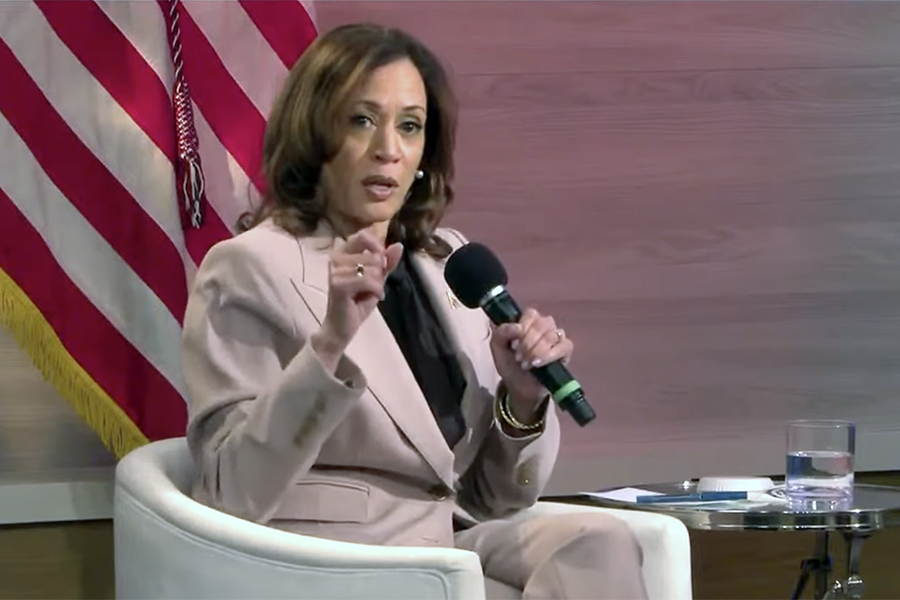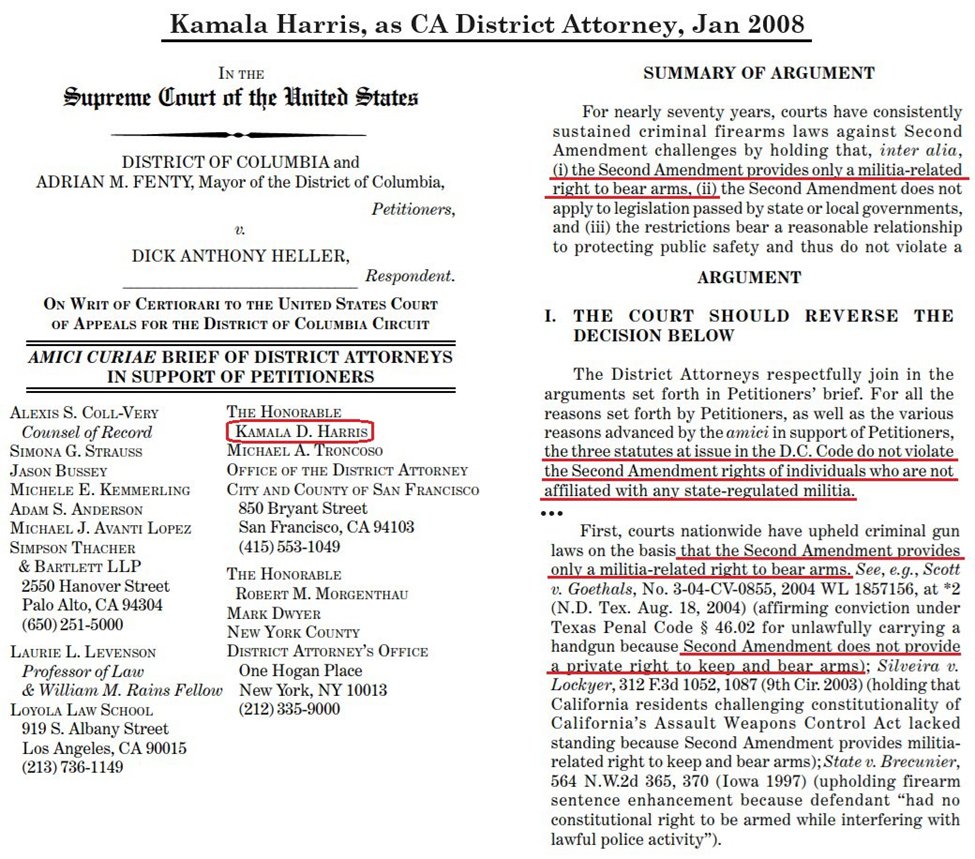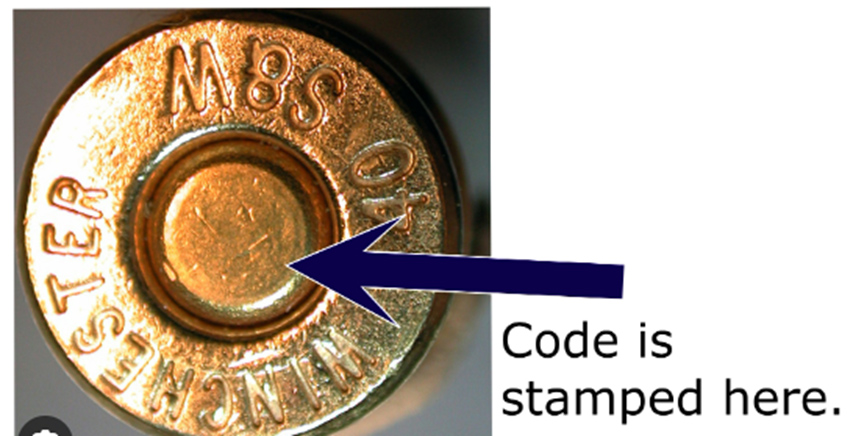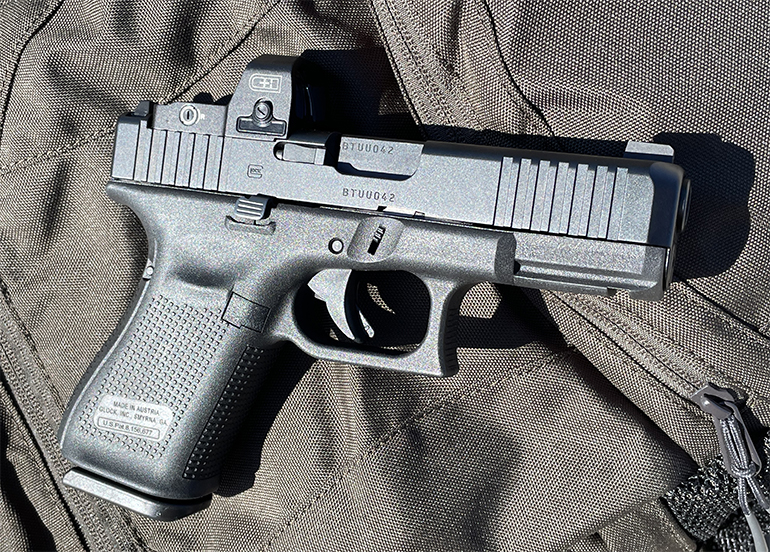
Kamala Harris has taken a sudden interest in projecting to voters that she isn’t opposed to gun rights, at least insofar as it pertains to handguns. In a recent appearance with Oprah Winfrey, she debuted her new stance on the Second Amendment. The Vice President, who had previously never met a gun control proposal she didn’t like, said that if “somebody breaks into my house, they’re getting shot. [laughter] Sorry, probably shouldn’t have said that! [more laughter] But my staff will deal with that later.”
Then, in an interview with 60 Minutes, when asked what kind of gun she has, Harris answered that she owns a GLOCK handgun but did not specify which model.
Paired with her constant new refrain that she and her running mate, Tim Walz, are gun owners, the Harris campaign wants to send the message to swing state voters that despite Kamala Harris advocating for universal background checks, red flag laws, and a ban on so-called “assault weapons” (i.e., common semiautomatic rifles), she is otherwise very much pro-Second Amendment. In other words, Americans’ right to own and acquire handguns is safe under a Harris administration.
The trouble is, there is little reason to believe this is anything more than election pandering. Harris’s well documented history makes her sudden claims of support for widespread handgun ownership laughable, as she has consistently opposed and obstructed that right for decades.
As district attorney in San Francisco, she backed Proposition H, which would have banned all handguns in the city had a lawsuit not stopped it. Later, she led an effort by many district attorneys to urge the Supreme Court to rule that there was no individual right to keep and bear arms at all, and then held a press conference to criticize the Heller ruling when the Supreme Court ultimately disagreed with her by accepting the individual rights interpretation of the Second Amendment.
In 2013, acting as California Attorney General, Harris implemented the state’s microstamping requirement under the California’s “Unsafe Handgun Act.” That effectively banned the sale of all modern handguns in California for a decade until litigation finally prevailed against it.
This article will also look at Harris’s hypocritical purported GLOCK ownership, a gun California defines as “unsafe”, regardless of what model and generation of GLOCK pistol it is. It will conclude with a series of questions that Harris should answer before the election.
Harris’s Support of Proposition H, the San Francisco Handgun Ban
As has now been covered by various outlets since the California Rifle & Pistol Association helped break the news, Kamala Harris supported a 2005 ballot measure that banned San Francisco residents from possessing pistols. As the San Jose Mercury News reported at the time, “Although Mayor Gavin Newsom has not taken a position, several of the city’s most liberal leaders are supporting the far-reaching ban — including District Attorney Kamala Harris and four supervisors who are listed as sponsors.” The measure also banned “all City residents, without exception, from selling, distributing, transferring and manufacturing firearms and ammunition.”
The CRPA, NRA, and Second Amendment Foundation sued to stop the ordinance from taking effect and were represented by Michel & Associates, P.C. In January 2008, a California state appeals court struck down Proposition H. It ruled San Francisco had overstepped its authority in instituting the ban.
“[T]he sheer breadth of Prop H makes it vulnerable to a preemption challenge,” Judge Ignazio John Ruvolo wrote for a unanimous state appeals court in Fiscal v. San Francisco.“As already noted, Section 2 of Prop H bans the ‘sale, manufacture, transfer or distribution’ of ammunition and firearms in the City, without exception. With narrow exceptions, Section 3 bans the possession of handguns by San Francisco residents, including possession within the sanctity of homes, businesses, and private property.”
In addition to losing on the merits of the legal claims, the court also ordered San Francisco to pay hundreds of thousands of dollars in legal fees to the plaintiffs as prevailing parties in the suit.
Harris Opposed the Individual Right Confirmed in the Supreme Court’s Heller Decision
In the Supreme Court’s landmark case on the Second Amendment, District of Columbia v. Heller, the high court ruled that the Second Amendment protects an individual right to keep and bear arms and does not require participation in a collective entity like a militia. It also held that statutes banning handgun possession in the home violate this core Second Amendment-protected right.
In the leadup to the case, Kamala Harris helped organize a coalition of district attorneys to submit an amicus curiae brief that expressly urged the Supreme Court to rule in favor of Washington, DC’s ban on handguns, and to rule that the Second Amendment “does not provide a private right to keep and bear arms”. Excerpts from that brief:

Following the Heller ruling against Harris’s position, she held a press event with then-Mayor of San Francisco Gavin Newsom to criticize the landmark decision. Kamala Harris’s comments can be seen here.
Attorney General Kamala Harris Implements the Microstamping Technology Requirement for Semiautomatic Pistols in California
(Note: a prior article went much more in depth on this topic, and the discussion is shortened and simplified here for the sake of brevity.)
In 1999, the California legislature enacted the Unsafe Handgun Act, which barred the sale of new handguns in California unless they passed certain safety tests and included certain “features.” If the guns passed, they were included on the state’s published handgun roster and able to be sold new in gun stores to the general firearms-eligible public.
This prohibition did not apply to law enforcement, nor to an ever-expanding list of other quasi-law enforcement type government agency personnel such as the Department of Motor Vehicles, harbor or port districts, and the investigation division of the Department of Consumer Affairs. Such exempt law enforcement personnel could continue to purchase handguns that California law deemed “unsafe” at retail firearms dealers.
This immediately constrained the California handgun market, however, a few new guns continued to make it onto California’s handgun roster by meeting California’s demands.
Enter Microstamping
Despite the strict requirements, one feature requirement passed by the legislature in 2007 had gone unenforced for years. The law included a mandate for microstamping, an experimental technology under which the firing pin of a pistol would include a microscopic array of characters that identify the make, model, and serial number of the pistol. The idea was that when the firing pin struck the cartridge to fire a bullet, it would leave an indentation on the spent casing that law enforcement could then use to identify the handgun used and its registered owner.

The idea was silly in several ways. Criminals usually use stolen guns, not their own, so identifying the registered owner of a gun was meaningless. At most, the identification mark would identify the initial lawful owner of the gun, from whom it was stolen.
Even if it was a gun the criminal had been purchased legally, they could easily file down the firing pin slightly to destroy the array of characters. Or they could replace the firing pin with another. Or they could make sure to collect their shell casings. Finally, they could just choose to use a revolver (which doesn’t leave casings behind) for their crimes.
But aside from the comical ineffectiveness of the idea, the technology has also simply never existed outside of a laboratory setting. Even the gun-hostile California legislature recognized this. That’s why they wrote into the law that the mandate would only take effect once the Attorney General “certifies that the technology used to create the imprint is available to more than one manufacturer unencumbered by any patent restrictions.”
Thus, microstamping didn’t take immediate effect and some new handguns continued to be added to the state’s roster, along with pre-2007 handgun models that were grandfathered in.
Attorney General Kamala Harris puts microstamping into effect, effectively banning the sale of new semiautomatic handguns in California.
On May 17, 2013, then-Attorney General of California Kamala Harris decided to issue a certification that microstamping technology was available to more than one manufacturer unencumbered by any patent restrictions. From then on, a semiautomatic handgun could only be sold in California if it had certain features and microstamping. The obvious issue was that the technology did not exist outside of a laboratory setting, and it still doesn’t today. Making a few microstamped firing pins for an experiment is one thing. Mass production is another.
As a result of Harris’s certification, no new semiautomatic handguns were added to the California roster from 2013 on, so the law effectively mandated obsolescence in the semiautomatic pistol market while citizens throughout the country could choose from the newest models.
Kamala Harris’s action meant the overwhelming majority of Californians who were not exempted from the law could not purchase popular handguns first released after 2013, such as all Gen 5 GLOCKs, the SIG SAUER P365, Smith & Wesson M&P M2.0 models, and many more from dozens of other arms makers. (CRPA and other plaintiffs finally got the microstamping requirement enjoined as unconstitutional in 2023 in a case called Boland v. Bonta. As a result, some new model semiautomatic handguns are finally being sold in California again for the first time in many years.)
The Hypocrisy of Kamala Harris’s GLOCK Handgun
In her interview with 60 Minutes, Kamala Harris claimed to own a GLOCK pistol. She doesn’t state what model, or which generation. In California, only Generation 3 or older GLOCKs can be sold to regular citizens because they were grandfathered onto the roster before several of its requirements took effect (and before microstamping). But they are still legally considered “unsafe” handguns, even though they can be sold due to the grandfathering. Why doesn’t Harris own a gun that California considers “safe” for regular citizens to purchase, considering her strong support and instrumental role she played in the Unsafe Handgun Act?
In fact, Harris not only supported the Roster by triggering the enforceability of the microstamping requirement, she also defended the law as Attorney General against various lawsuits, including in Pena v. Lindley. There, she argued that, among other things, the roster was constitutional even though it required microstamping and other features missing from GLOCK pistols, and despite having prevented new handguns from being sold in the state.
Thus, if Harris owns a Generation 3 or older GLOCK, she is a hypocrite for owning a handgun that she herself has argued is “unsafe.”
But the hypocrisy gets even worse if she owns a more modern generation GLOCK pistol. GLOCK has continued to make the Generation 3 models almost solely for the California market, but its Generation 4 and 5 models, which are popular in the rest of the country, can’t be sold new to regular citizens in California. Only legally exempt individuals (such as law enforcement) can buy them.

If Kamala Harris has a Generation 4 or 5 GLOCK handgun, then she has a handgun that can’t be sold new to regular citizens in California thanks to a law she supported, expanded, and defended in court as Attorney General. While she enjoys the more modern pistol for her own protection, regular Californians have to either pay a fortune to buy that same gun (which was originally purchased under the carve-out) secondhand in the resale market, or they must settle for a handgun Kamala Harris and the law she backed has deemed “safe” enough for them.
Questions reporters should ask Kamala Harris.
Given all of the above, any reporter who interviews Kamala should ask her:
- You have said on the campaign trail that your values have not changed. Does that apply to your position on gun rights?
- Do you regret your support of Proposition H in San Francisco? If so, why? Please be specific.
- Do you stand by your amicus brief to the Supreme Court in Heller, in which you urged the Court to rule that there was no individual right to keep and bear arms (including handguns)? If your mind has changed and you now support that ruling, what caused the change?
- Do you stand by your actions as Attorney General of California, which led to an effective decade-long ban on the sale of modern handguns to regular California citizens until the law was declared unconstitutional last year? If so, how do you square that with your recent statements that make it sound like you do not oppose the right to own handguns?
- Why do you own a GLOCK handgun, given the California Unsafe Handgun Act declares them to be “unsafe”?
- What generation of GLOCK is it? What model?
- What is its magazine capacity?
- How did you acquire it? From whom – a retail dealer or a private party transfer?
- Is this the same firearm you had when you were a prosecutor or was it purchased after you left that position?
- You have stated you have smoked marijuana before, correct? Are you aware that federal law prohibits people who smoke marijuana from owning a firearm? Did you smoke marijuana while owning and possessing a firearm? Do you support ending the federal restriction barring marijuana users from possessing firearms?
Konstadinos Moros is an Associate Attorney with Michel & Associates, a law firm in Long Beach that regularly represents the California Rifle & Pistol Association (CRPA) in its litigation efforts to restore the Second Amendment in California. You can find him on his Twitter handle @MorosKostas. To donate to CRPA or become a member, visit https://crpa.org/.
This post was adapted by SNW from an X article posted by Konstadinos Moros.


11: You belong to an organization that put my countrymen in concentration camps. Why shouldn’t your attempt to disarm us be immediately dismissed?
Great questions. If you have extra time, ask her how often she trains with her Glock and when did she last shoot it?
Asking her a question and expecting an honest answer is like trying to teach a pig to sing and expecting it to sing a song. It wastes your time and annoys the pig.
You could also ask her if she has ever heard of US Code, Chapter 12, section 246, and if she agrees with the stated definition of the term “militia”.